Zhou Wang
Omnidirectional Image Quality Captioning: A Large-scale Database and A New Model
Feb 21, 2025Abstract:The fast growing application of omnidirectional images calls for effective approaches for omnidirectional image quality assessment (OIQA). Existing OIQA methods have been developed and tested on homogeneously distorted omnidirectional images, but it is hard to transfer their success directly to the heterogeneously distorted omnidirectional images. In this paper, we conduct the largest study so far on OIQA, where we establish a large-scale database called OIQ-10K containing 10,000 omnidirectional images with both homogeneous and heterogeneous distortions. A comprehensive psychophysical study is elaborated to collect human opinions for each omnidirectional image, together with the spatial distributions (within local regions or globally) of distortions, and the head and eye movements of the subjects. Furthermore, we propose a novel multitask-derived adaptive feature-tailoring OIQA model named IQCaption360, which is capable of generating a quality caption for an omnidirectional image in a manner of textual template. Extensive experiments demonstrate the effectiveness of IQCaption360, which outperforms state-of-the-art methods by a significant margin on the proposed OIQ-10K database. The OIQ-10K database and the related source codes are available at https://github.com/WenJuing/IQCaption360.
Structural Similarity in Deep Features: Image Quality Assessment Robust to Geometrically Disparate Reference
Dec 27, 2024Abstract:Image Quality Assessment (IQA) with references plays an important role in optimizing and evaluating computer vision tasks. Traditional methods assume that all pixels of the reference and test images are fully aligned. Such Aligned-Reference IQA (AR-IQA) approaches fail to address many real-world problems with various geometric deformations between the two images. Although significant effort has been made to attack Geometrically-Disparate-Reference IQA (GDR-IQA) problem, it has been addressed in a task-dependent fashion, for example, by dedicated designs for image super-resolution and retargeting, or by assuming the geometric distortions to be small that can be countered by translation-robust filters or by explicit image registrations. Here we rethink this problem and propose a unified, non-training-based Deep Structural Similarity (DeepSSIM) approach to address the above problems in a single framework, which assesses structural similarity of deep features in a simple but efficient way and uses an attention calibration strategy to alleviate attention deviation. The proposed method, without application-specific design, achieves state-of-the-art performance on AR-IQA datasets and meanwhile shows strong robustness to various GDR-IQA test cases. Interestingly, our test also shows the effectiveness of DeepSSIM as an optimization tool for training image super-resolution, enhancement and restoration, implying an even wider generalizability. \footnote{Source code will be made public after the review is completed.
HybridMQA: Exploring Geometry-Texture Interactions for Colored Mesh Quality Assessment
Dec 02, 2024Abstract:Mesh quality assessment (MQA) models play a critical role in the design, optimization, and evaluation of mesh operation systems in a wide variety of applications. Current MQA models, whether model-based methods using topology-aware features or projection-based approaches working on rendered 2D projections, often fail to capture the intricate interactions between texture and 3D geometry. We introduce HybridMQA, a first-of-its-kind hybrid full-reference colored MQA framework that integrates model-based and projection-based approaches, capturing complex interactions between textural information and 3D structures for enriched quality representations. Our method employs graph learning to extract detailed 3D representations, which are then projected to 2D using a novel feature rendering process that precisely aligns them with colored projections. This enables the exploration of geometry-texture interactions via cross-attention, producing comprehensive mesh quality representations. Extensive experiments demonstrate HybridMQA's superior performance across diverse datasets, highlighting its ability to effectively leverage geometry-texture interactions for a thorough understanding of mesh quality. Our implementation will be made publicly available.
Perceptual Quality Assessment of Trisoup-Lifting Encoded 3D Point Clouds
Oct 09, 2024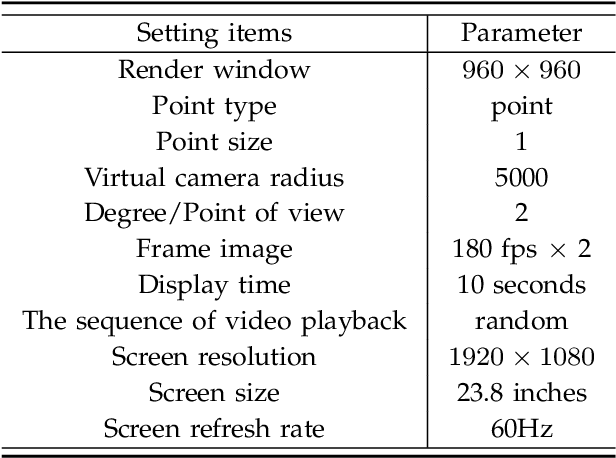
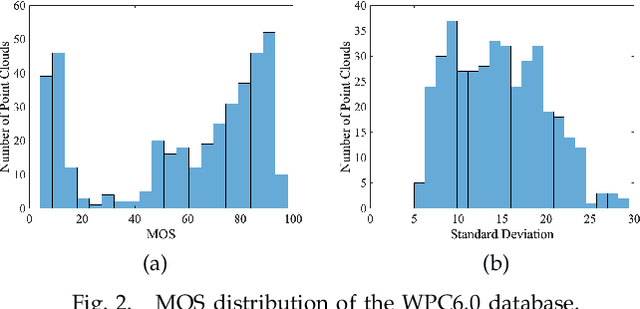
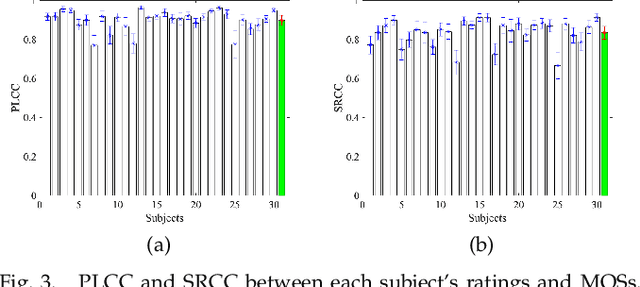
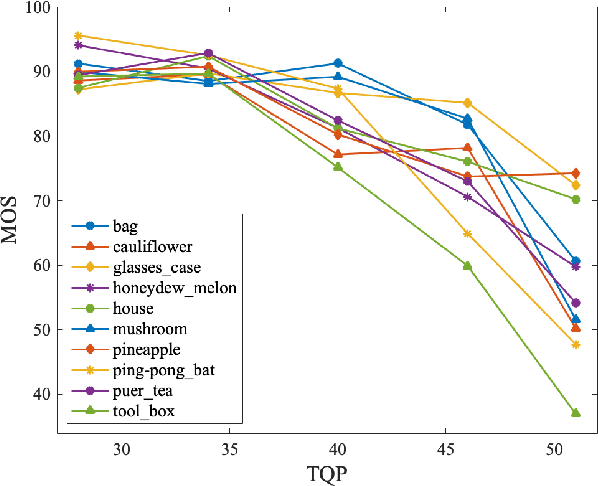
Abstract:No-reference bitstream-layer point cloud quality assessment (PCQA) can be deployed without full decoding at any network node to achieve real-time quality monitoring. In this work, we develop the first PCQA model dedicated to Trisoup-Lifting encoded 3D point clouds by analyzing bitstreams without full decoding. Specifically, we investigate the relationship among texture bitrate per point (TBPP), texture complexity (TC) and texture quantization parameter (TQP) while geometry encoding is lossless. Subsequently, we estimate TC by utilizing TQP and TBPP. Then, we establish a texture distortion evaluation model based on TC, TBPP and TQP. Ultimately, by integrating this texture distortion model with a geometry attenuation factor, a function of trisoupNodeSizeLog2 (tNSL), we acquire a comprehensive NR bitstream-layer PCQA model named streamPCQ-TL. In addition, this work establishes a database named WPC6.0, the first and largest PCQA database dedicated to Trisoup-Lifting encoding mode, encompassing 400 distorted point clouds with both 4 geometric multiplied by 5 texture distortion levels. Experiment results on M-PCCD, ICIP2020 and the proposed WPC6.0 database suggest that the proposed streamPCQ-TL model exhibits robust and notable performance in contrast to existing advanced PCQA metrics, particularly in terms of computational cost. The dataset and source code will be publicly released at \href{https://github.com/qdushl/Waterloo-Point-Cloud-Database-6.0}{\textit{https://github.com/qdushl/Waterloo-Point-Cloud-Database-6.0}}
Perceptual Depth Quality Assessment of Stereoscopic Omnidirectional Images
Aug 19, 2024Abstract:Depth perception plays an essential role in the viewer experience for immersive virtual reality (VR) visual environments. However, previous research investigations in the depth quality of 3D/stereoscopic images are rather limited, and in particular, are largely lacking for 3D viewing of 360-degree omnidirectional content. In this work, we make one of the first attempts to develop an objective quality assessment model named depth quality index (DQI) for efficient no-reference (NR) depth quality assessment of stereoscopic omnidirectional images. Motivated by the perceptual characteristics of the human visual system (HVS), the proposed DQI is built upon multi-color-channel, adaptive viewport selection, and interocular discrepancy features. Experimental results demonstrate that the proposed method outperforms state-of-the-art image quality assessment (IQA) and depth quality assessment (DQA) approaches in predicting the perceptual depth quality when tested using both single-viewport and omnidirectional stereoscopic image databases. Furthermore, we demonstrate that combining the proposed depth quality model with existing IQA methods significantly boosts the performance in predicting the overall quality of 3D omnidirectional images.
Perceptual Crack Detection for Rendered 3D Textured Meshes
May 09, 2024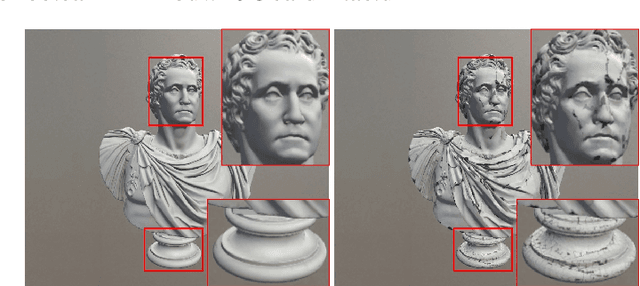


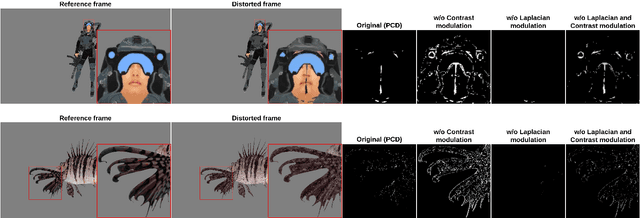
Abstract:Recent years have witnessed many advancements in the applications of 3D textured meshes. As the demand continues to rise, evaluating the perceptual quality of this new type of media content becomes crucial for quality assurance and optimization purposes. Different from traditional image quality assessment, crack is an annoying artifact specific to rendered 3D meshes that severely affects their perceptual quality. In this work, we make one of the first attempts to propose a novel Perceptual Crack Detection (PCD) method for detecting and localizing crack artifacts in rendered meshes. Specifically, motivated by the characteristics of the human visual system (HVS), we adopt contrast and Laplacian measurement modules to characterize crack artifacts and differentiate them from other undesired artifacts. Extensive experiments on large-scale public datasets of 3D textured meshes demonstrate effectiveness and efficiency of the proposed PCD method in correct localization and detection of crack artifacts. %Specifically, We propose a full-reference crack artifact localization method that operates on a pair of input snapshots of distorted and reference 3D objects to generate a final crack map. Moreover, to quantify the performance of the proposed detection method and validate its effectiveness, we propose a simple yet effective weighting mechanism to incorporate the resulting crack map into classical quality assessment (QA) models, which creates significant performance improvement in predicting the perceptual image quality when tested on public datasets of static 3D textured meshes. A software release of the proposed method is publicly available at: https://github.com/arshafiee/crack-detection-VVM
Efficient Online Set-valued Classification with Bandit Feedback
May 07, 2024

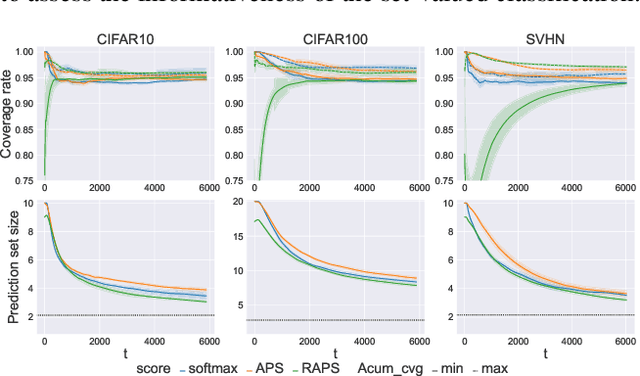
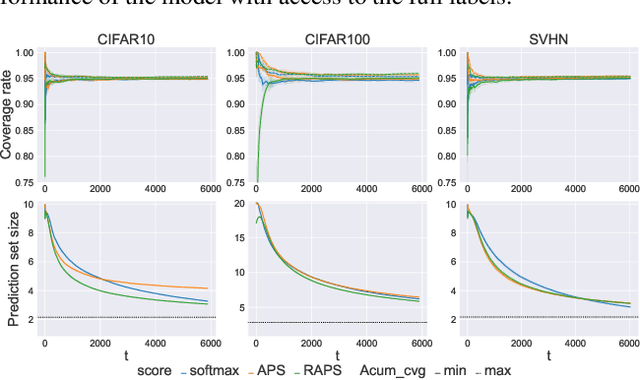
Abstract:Conformal prediction is a distribution-free method that wraps a given machine learning model and returns a set of plausible labels that contain the true label with a prescribed coverage rate. In practice, the empirical coverage achieved highly relies on fully observed label information from data both in the training phase for model fitting and the calibration phase for quantile estimation. This dependency poses a challenge in the context of online learning with bandit feedback, where a learner only has access to the correctness of actions (i.e., pulled an arm) but not the full information of the true label. In particular, when the pulled arm is incorrect, the learner only knows that the pulled one is not the true class label, but does not know which label is true. Additionally, bandit feedback further results in a smaller labeled dataset for calibration, limited to instances with correct actions, thereby affecting the accuracy of quantile estimation. To address these limitations, we propose Bandit Class-specific Conformal Prediction (BCCP), offering coverage guarantees on a class-specific granularity. Using an unbiased estimation of an estimand involving the true label, BCCP trains the model and makes set-valued inferences through stochastic gradient descent. Our approach overcomes the challenges of sparsely labeled data in each iteration and generalizes the reliability and applicability of conformal prediction to online decision-making environments.
Generated Contents Enrichment
May 06, 2024Abstract:In this paper, we investigate a novel artificial intelligence generation task, termed as generated contents enrichment (GCE). Different from conventional artificial intelligence contents generation task that enriches the given textual description implicitly with limited semantics for generating visually real content, our proposed GCE strives to perform content enrichment explicitly on both the visual and textual domain, from which the enriched contents are visually real, structurally reasonable, and semantically abundant. Towards to solve GCE, we propose a deep end-to-end method that explicitly explores the semantics and inter-semantic relationships during the enrichment. Specifically, we first model the input description as a semantic graph, wherein each node represents an object and each edge corresponds to the inter-object relationship. We then adopt Graph Convolutional Networks on top of the input scene description to predict the enriching objects and their relationships with the input objects. Finally, the enriched graph is fed into an image synthesis model to carry out the visual contents generation. Our experiments conducted on the Visual Genome dataset exhibit promising and visually plausible results.
AutoML for Large Capacity Modeling of Meta's Ranking Systems
Nov 16, 2023
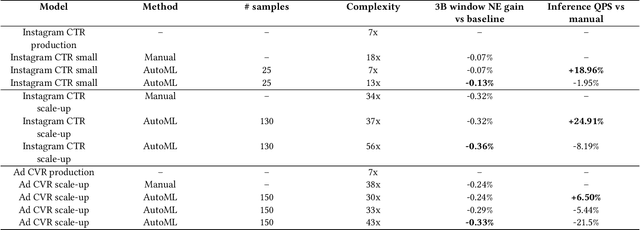
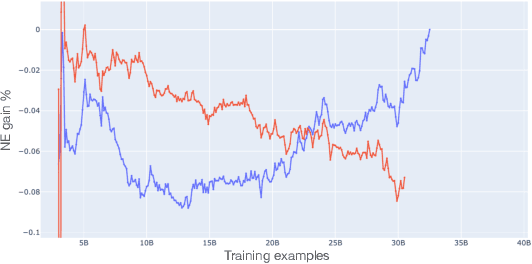

Abstract:Web-scale ranking systems at Meta serving billions of users is complex. Improving ranking models is essential but engineering heavy. Automated Machine Learning (AutoML) can release engineers from labor intensive work of tuning ranking models; however, it is unknown if AutoML is efficient enough to meet tight production timeline in real-world and, at the same time, bring additional improvements to the strong baselines. Moreover, to achieve higher ranking performance, there is an ever-increasing demand to scale up ranking models to even larger capacity, which imposes more challenges on the efficiency. The large scale of models and tight production schedule requires AutoML to outperform human baselines by only using a small number of model evaluation trials (around 100). We presents a sampling-based AutoML method, focusing on neural architecture search and hyperparameter optimization, addressing these challenges in Meta-scale production when building large capacity models. Our approach efficiently handles large-scale data demands. It leverages a lightweight predictor-based searcher and reinforcement learning to explore vast search spaces, significantly reducing the number of model evaluations. Through experiments in large capacity modeling for CTR and CVR applications, we show that our method achieves outstanding Return on Investment (ROI) versus human tuned baselines, with up to 0.09% Normalized Entropy (NE) loss reduction or $25\%$ Query per Second (QPS) increase by only sampling one hundred models on average from a curated search space. The proposed AutoML method has already made real-world impact where a discovered Instagram CTR model with up to -0.36% NE gain (over existing production baseline) was selected for large-scale online A/B test and show statistically significant gain. These production results proved AutoML efficacy and accelerated its adoption in ranking systems at Meta.
Perceptual Quality Assessment of 360$^\circ$ Images Based on Generative Scanpath Representation
Sep 07, 2023



Abstract:Despite substantial efforts dedicated to the design of heuristic models for omnidirectional (i.e., 360$^\circ$) image quality assessment (OIQA), a conspicuous gap remains due to the lack of consideration for the diversity of viewing behaviors that leads to the varying perceptual quality of 360$^\circ$ images. Two critical aspects underline this oversight: the neglect of viewing conditions that significantly sway user gaze patterns and the overreliance on a single viewport sequence from the 360$^\circ$ image for quality inference. To address these issues, we introduce a unique generative scanpath representation (GSR) for effective quality inference of 360$^\circ$ images, which aggregates varied perceptual experiences of multi-hypothesis users under a predefined viewing condition. More specifically, given a viewing condition characterized by the starting point of viewing and exploration time, a set of scanpaths consisting of dynamic visual fixations can be produced using an apt scanpath generator. Following this vein, we use the scanpaths to convert the 360$^\circ$ image into the unique GSR, which provides a global overview of gazed-focused contents derived from scanpaths. As such, the quality inference of the 360$^\circ$ image is swiftly transformed to that of GSR. We then propose an efficient OIQA computational framework by learning the quality maps of GSR. Comprehensive experimental results validate that the predictions of the proposed framework are highly consistent with human perception in the spatiotemporal domain, especially in the challenging context of locally distorted 360$^\circ$ images under varied viewing conditions. The code will be released at https://github.com/xiangjieSui/GSR
 Add to Chrome
Add to Chrome Add to Firefox
Add to Firefox Add to Edge
Add to Edge